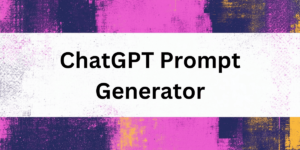As a product manager, keeping up with the latest market trends and continuously improving your product is a must. However, it can be challenging to stay on track while juggling a multitude of responsibilities. Luckily, with the help of chatGPT’s artificial intelligence (AI) prompts, product managers can have access to a revolutionary tool that streamlines their tasks and improves their workflow. Say goodbye to the stress of managing numerous deadlines and staying on top of market trends! With chatGPT, product managers can experience increased efficiency and productivity, making their roles easier and more manageable than ever before.
1. Boosting Productivity: Chatbot for Product Managers
As a product manager, you know how challenging it can be to stay on top of everything. You need to make sure your team is working efficiently and that your product is meeting users’ needs. That’s where the Chatgpt chatbot comes in – it can help you boost productivity and streamline your management processes.
With Chatgpt, you can create and get new ideas faster than ever before. The prompt function will help you get started on your next project by giving you the words you need to make sense of your thoughts in the moment. Plus, the chatbot can help you get valuable feedback from users and track important customer data that will help you make informed decisions.
Another great thing about Chatgpt is that it can help you make your team more efficient. The chatbot can help team members stay organized and on-task by prompting them with reminders, to-do lists, and other helpful prompts. This will help you ensure that everyone is working together effectively to create a great product.
Overall, if you’re a product manager looking to make your life a bit easier, you should definitely consider using Chatgpt. It’s an easy-to-use tool that will help you get the help you need, when you need it. Plus, with its user-friendly interface, it’s easy to get your team on board and begin using it right away. Try it out today and see how it can help you elevate your product management game!
To learn more about how AI chat tools can streamline your work as a product manager, visit:
2. Why Product Managers Need AI Chatbots
Product managers have a lot on their plates, from creating new products to managing teams of users and customers. But with advances in technology, there’s a new tool in their arsenal: AI chatbots. These chatbots, like Chatgpt, can help managers streamline their processes and boost productivity.
How can chatbots help product managers? First, they can help managers get feedback from customers and users. By using prompts and natural language processing, chatbots can gather valuable data that can inform product development. They can also help managers get new ideas for products and features.
Chatbots can also help managers make better decisions. By using prompts to ask the right questions, they can help managers identify problems and find solutions. And because chatbots are available 24/7, they can provide help and support to users whenever they need it.
One of the biggest benefits of chatbots is that they can simplify product management. They can take care of repetitive tasks like data entry and organization, freeing up time for managers to focus on higher-level work. And because chatbots are always learning, they can adapt to changing circumstances and improve over time.
In short, AI chatbots like Chatgpt are a powerful tool for product managers. They can help managers create better products, get feedback from users, and streamline their processes. Using prompts and natural language processing, chatbots can make product management easier and more effective. So if you’re a product manager looking to boost your productivity, consider giving Chatgpt a try..
If you’re a product manager seeking to elevate your management game, consider using ChatGPT, an easy-to-use tool that boosts productivity and streamlines processes. For valuable insights and practical use cases with ChatGPT, explore Top 20 Most Important Prompts for Product Managers by Anil Tilbe.
3. Streamlining Processes with GPT-prompted Chatbots
If you’re a product manager, you already know how challenging it is to stay on top of everything. From gathering customer feedback to managing the team, the list of tasks never seem to end. But what if I told you that there’s a way to streamline some of those processes?
Enter GPT-prompted chatbots. These chatbots are artificial intelligence assistants designed to help product managers create new products, get feedback from users, and make data-driven decisions. With chatgpt, you can get quick assistance on ideas and prompts for creating new products. And the best part is, chatgpt can help you at any time.
GPT-prompted chatbots can also be beneficial in managing teams. As a product manager, you’re responsible for ensuring that everyone on your team is aligned and working towards the same goals. Using chatgpt, you can prompt your team to share their ideas and thoughts on new products. This can help you get an idea of what your team is thinking, and make better decisions based on this feedback.
Chatbots can also help with gathering customer feedback. As you know, customer feedback is crucial for creating new products that will resonate with your users. With a chatbot, you can gather feedback and suggestions from your users easily and quickly. This can be incredibly helpful when you’re looking to improve your product or create something new.
Overall, GPT-prompted chatbots are a game-changer for product management. They can help with creating new products, managing teams, and gathering feedback from users. If you’re a product manager looking to streamline some of your processes, using a chatbot like chatgpt could be the perfect solution for you..
To learn more about how AI chatbots can streamline your product management process, visit this link:
4. Elevating Product Management with Chatgpt
The world of product management has changed drastically with the advent of chatbots. The Chatgpt chatbot has revolutionized the way product managers work by providing them with prompt assistance in all aspects of their job. It has become an indispensable tool for managers who want to leverage the power of AI chatbots to make their job easier.
With Chatgpt, creating new products has become more streamlined. The chatbot can help you gather customer feedback and ideas to make better products. The customer data that the chatbot collects is incredibly valuable in guiding product development, making sure your product is well-received by users.
As a product manager, you’re working with a team to make your product the best it can be. Chatgpt is an excellent way to help everyone on your team stay on the same page. By using the chatbot, you can ensure that everyone is up to date on the latest developments and that all the team members have access to the same information. This makes the decision-making process much more efficient.
Chatgpt also helps product managers get a better understanding of their users. By processing data and user feedback, the chatbot can provide insights into how users are interacting with the product. This knowledge can help managers make informed decisions and ensure that they’re meeting their users’ needs.
In short, Chatgpt has elevated the role of product managers, making it easier to manage their workloads, improve their products, and connect with users. With the chatbot’s help, product managers can make better decisions, create better products, and achieve their goals much more efficiently. So if you’re a product manager looking to make your job easier, Chatgpt is the tool you need!.
GPT-prompted chatbots, like ChatGPT, can greatly assist product managers in creating new products, managing teams, and gathering crucial customer feedback. By streamlining processes, these AI-powered chatbots can transform product management and help teams achieve their goals efficiently.
Learn more about GPT-prompted chatbots in product management:
ChatGPT Prompts for Product Managers: How They Can Change the Game
5. Product Management Simplified: Chatbot Assistance
Are you a product manager struggling to keep up with all your responsibilities? Well, there’s good news! Chatbot assistance is here to help make your life easier. Chatgpt is a new AI-powered chatbot designed specifically for product managers like you. With Chatgpt, you can create new product ideas, get feedback from users, and streamline your management processes all in one place.
Using Chatgpt is easy. Simply prompt the chatbot with one of the many built-in prompts, and you’ll receive helpful responses immediately. If you’re stuck on a new product idea, just ask Chatgpt for help. Need to make sense of customer data quickly? Chatgpt can do that too. It’s the ultimate tool for modern product managers who need help balancing multiple projects at once.
And the best part? Chatgpt is always learning. As you use the chatbot, it gets smarter and can provide even more helpful responses. So, if you want to elevate your product management game and receive prompt assistance with prompt new ideas, Chatgpt is the perfect solution. Try it today and see for yourself just how helpful it can be for you and your team.
Our ChatGPT Prompts for Product Managers
- Generating product ideas and concepts: Generate X new product ideas for a Y (e.g., an organization that sells outdoor gear).
- Conducting market research and competitor analysis: What are the main trends in the X industry, and how can our Y (e.g., company, group, team, or organization) capitalize on them?
- Writing product descriptions and user manuals: Create a user manual for our X software, including step-by-step instructions for key features.
- Creating product roadmaps and timelines: Develop a timeline for the launch of our new X product, including key tasks and deadlines.
- Developing go-to-market strategies: What are the key elements of a successful go-to-market strategy for our X product?
- Creating product launch plans and press releases: Develop a launch plan for our new X product, including y (e.g., key milestones and timelines).
- Generating customer personas and user profiles: What are the key characteristics of our ideal customer for the X product?
- Assessing customer needs and feedback: What are the most common customer complaints and feedback related to our X product?
- Identifying and tracking key performance indicators: How can we use KPIs to inform our product development for X?
- Generating product pricing strategies: How can we use market research and customer data to inform our pricing strategy for X?
- Writing product-related emails and presentations: Develop a script for a product demo for our X product
- Generating feature lists and product requirements: What are the key user experience considerations for our X product?
- Developing and analyzing A/B test plans: What are the most important metrics to track for an A/B test of our X product?
- Generating sales and marketing materials: Create a product FAQ document to address common customer questions about our X product
- Analyzing and tracking product performance metrics: What are the key metrics for customer acquisition for our X product?
- Developing and implementing product feature requests: What are the key metrics we should track to measure the success of implemented feature requests for our X product?
- Conducting customer interviews and surveys: How can we analyze and interpret the data from customer interviews and surveys for our X product?
- Generating product documentation and user guides: Create an installation guide for our X product
- Tracking and analyzing industry trends: What are the key industry players and competitors in our market for X products?
- Collaborating with cross-functional teams and stakeholders: How can we use data and feedback from cross-functional teams and stakeholders to inform our product development for X?
Useful tips
- Tip 1: Collaborate with cross-functional teams
Product managers should work with development, design, marketing, and other teams to ensure that the product is meeting the customer’s needs. Regular meetings and communication can lead to a better understanding of the requirements, reduce launch delays, and improve the product’s success in the market.
- Tip 2: Know your market
A good product manager should conduct research to determine customer needs, interests, preferences, and behaviors to inform product development. This information can be used to create products that better meet market needs than competitors
- Tip 3: Prioritize features
Product managers should prioritize product features based on data, customer feedback, problem-solving, and business goals. This ensures the focus of development on valuable features, avoids feature bloat, and sets a clear direction for the product.
- Tip 4: Define clear product requirements
One of the product manager’s core responsibilities is to outline the product requirements and specifications, including functional requirements, product features, and user stories. Creating a detailed product description helps development and design teams create what is needed while reducing misunderstandings and mistakes.
- Tip 5: Keep learning
Product managers should stay up to date with emerging technologies, new products, and industry trends. They should read product management books, articles, and attend conferences to learn best practices and gain fresh perspectives to improve their decision making and keep their product relevant.
Other People asked
What are some key responsibilities of a product manager?
A product manager is responsible for developing and executing a product strategy that fits business objectives and meets customer needs. This involves conducting market research, defining product requirements, collaborating with cross-functional teams, setting pricing and packaging strategies, measuring product performance, and continuously improving the product. Additionally, a product manager must communicate and champion the product vision internally and externally, manage stakeholder expectations, and make data-driven decisions to achieve business goals.
How can product managers prioritize their product roadmap?
Product managers can prioritize their product roadmap by focusing on business objectives, customer needs, and user data. This involves setting clear goals and criteria for product features, assessing customer feedback and user behavior data, and analyzing market trends and competition. By weighing each feature against its potential impact on the business and customer experience, product managers can develop a product roadmap that aligns with business goals and customer needs. It’s essential to regularly reassess and adjust the product roadmap to adapt to changing market conditions and feedback from customers and stakeholders.
How can product managers effectively collaborate with cross-functional teams?
Product managers can effectively collaborate with cross-functional teams by fostering communication and teamwork, setting clear expectations and goals, and establishing regular feedback loops. This involves building strong relationships with team members and stakeholders, maintaining open communication channels, and understanding each team member’s role and responsibilities. Additionally, product managers should provide context and guidance to ensure that team members are aligned with the product vision and strategy, and be open to feedback and ideas from others to improve the product. Regularly scheduled meetings, progress reports, and check-ins can also help keep the team on track and identify areas for improvement.
What are some common challenges product managers face, and how can they overcome them?
Some common challenges product managers face include defining and prioritizing product features, managing stakeholder expectations, balancing competing priorities, staying aligned with the product vision, and adapting to changing market conditions. Product managers can overcome these challenges by engaging in continuous learning and development, building strong relationships with team members and stakeholders, and staying data-driven and customer-focused. Being open to feedback and collaboration, and regularly reassessing and adjusting the product roadmap, can also help product managers overcome challenges and achieve success.
How can product managers measure the success of their product?
Product managers can measure the success of their product by analyzing key performance indicators (KPIs) and user behavior data. KPIs such as revenue, customer acquisition, retention, and satisfaction, can provide insight into the product’s overall performance and impact on the business. Additionally, product managers can use user behavior data such as retention rates, churn, and engagement metrics to monitor user adoption and satisfaction with the product. By regularly tracking and analyzing these metrics, product managers can gain insights into which features and strategies are most successful, and make data-driven decisions to improve the product and achieve business goals.
Related Questions
What are the benefits of meditation?
Meditation has numerous benefits for both the mind and body. It can reduce stress and anxiety, improve focus and concentration, boost the immune system, increase self-awareness, and promote overall feelings of happiness and well-being. Meditation involves slowing down the mind and focusing on the present moment, which can help to alleviate negative thoughts and emotions. Regular practice of meditation has even been shown to lower blood pressure and decrease symptoms of depression. Additionally, meditation can be a helpful tool for improving sleep quality, promoting feelings of relaxation, and increasing creativity and productivity.
How can I start a healthy eating plan?
Starting a healthy eating plan can be a daunting task, but it’s important to take small steps and make gradual changes to your diet. Begin by incorporating more fruits and vegetables into your meals, and try to choose whole grains over refined grains whenever possible. Limit your intake of processed foods and foods high in saturated fats and sugars. Drink plenty of water throughout the day, and try to reduce your consumption of sugary drinks like soda. Planning out your meals and snacks ahead of time can also help you stay on track with your healthy eating goals. Remember that a healthy eating plan doesn’t have to be restrictive or boring – there are plenty of delicious and nutritious options to choose from!
Conclusion
In conclusion, ChatGPT prompts can be very beneficial for product managers. These prompts can help product managers to identify different aspects of their work that require their attention and help them stay on track. The prompts can also assist in generating new ideas and solutions to problems. By using ChatGPT prompts, product managers can streamline their work and become more efficient. The main learning of this article is that ChatGPT prompts can be a valuable tool for product managers, and incorporating them into their workflow can help them navigate the challenges of their role with more ease.


















